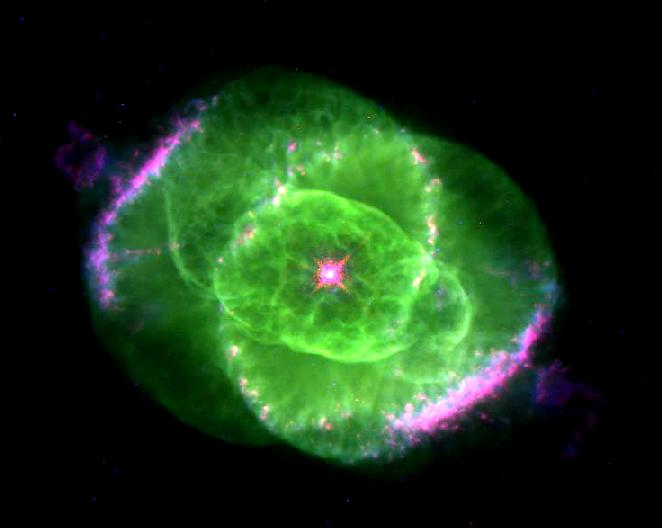Today's APOD is from 1995.
For a long time, HST images were not "standardized" when it comes to how mapped color was shown. Today, OIII emission is usually shown as blue, Hα as green and SII (or NII) as red. This consistent treatment of color in mapped color images makes it so much easier to understand what we are seeing in them.
In today's APOD, according to
this page, red represents Hα (obviously), blue represents neutral oxygen at 6300 angstroms (what????) and green represents ionized nitrogen at 6584 angstroms. This choice of color leads to an extremely red portrait of NGC 6543, with a pair of odd extremely green "wings" and an intensely blue central star.
NGC 40. Photo: CRCiencia.
NGC 6543, the Cat's Eye Nebula. Photo: Adam Block/NOAO/AURA/NSF
The fact that the Cat's Eye Nebula is made to look so red in today's APOD is very unfortunate, due to the fact that some planetary nebulas really are very red. One example is NGC 40, which seems to lack OIII emission altogether. Most planetary nebulas are not like that, however, and NGC 6543 certainly isn't. Adam Block's old but chromatically very accurate image from 2003 shows that the Cat's Eye is dominated by green OIII emission, with some Hα in the mix. The "wings" that look so oddly green in today's APOD are clearly red in Block's image.
We learn as we go, and nowadays the Hubble images are colorized in a way that allows most of the pictures to be "read" at a glance. That was not the case in the early days of HST. To appreciate how fast and loose HST image processors have played with color particularly when producing planetary nebula images, take a look at
this 1.4 MB image. (Yes, I know that some objects there aren't planetaries.)
So the best thing I can say about today's APOD is that, yes, you've come a long way, Hubble-baby.
Ann
 The Cat's Eye Nebula
The Cat's Eye Nebula

